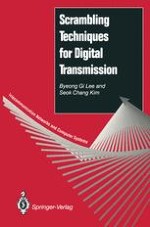1994 | Buch
Scrambling Techniques for Digital Transmission
verfasst von: Byeong Gi Lee, BS, ME, PhD, Seok Chang Kim, BS, ME, PhD
Verlag: Springer London
Buchreihe : Telecommunication Networks and Computer Systems
Enthalten in: Professional Book Archive
